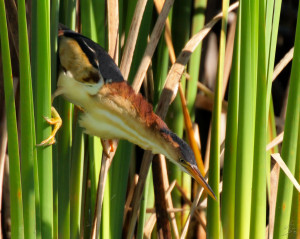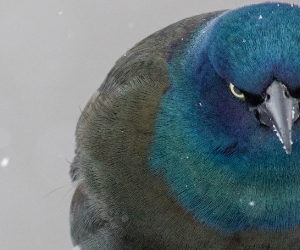Species Spotlight: Least Bittern
Get to know some of the species at risk in the Lac Deschênes IBA with the Species Spotlight, aka “Sp-Spot”. Today meet the: Least Bittern

Photo by Eric Begin
Scientific Name: Ixobrychus exilis
SARA Status: Threatened; Ontario: Threatened; Quebec: Vulnerable
Taxonomic Group: Birds
Size: length of 28-36 cm, wingspan of 41-46 cm
Least Bitterns are slightly larger than an American Robin. The Least Bittern has buffy and brown plumage with buff streaks on its white underside. Its back and crown are black in males and lighter in females and juveniles. It has a buffy patch on its wing that is visible in flight. The biggest threats to them are loss and degradation of habitat. Least Bitterns have declined in Canada by 30% in the last ten years. They eat frogs, small fish and aquatic insects. They nest on a platform of marsh vegetation above the water. Their typically heard call is a hollow, quiet “coo-coo-coo”.
Where else can you see this species?
Least Bitterns are found from southern Canada to South America. In Canada they are found in southern Ontario, Manitoba, Quebec and New Brunswick. They can be found foraging in cattail marshes that have open water. You may find Least Bitterns in the Ottawa area at Constance Creek and at Lac La Pech and they have been found in the Lac Deschenes IBA at Mud Lake. They are migratory and spend the winter in the southern United States and in Central America.
Did you know?
• There is a rare colour variation called the Cory’s bittern which has a darker plumage than the Least Bittern. It used to be found at Ashbrides Bay Marsh in Toronto but is now much rarer throughout North America.
• Least Bitterns are the smallest member of the heron family in North America. Other members include the Great Blue Heron, the Boat-billed Heron and all of the Egret species.
• Least Bitterns are masters of disguise in their marshy habitats, so listen for this bird in the early morning and evening.
• When alarmed, the Least Bittern freezes in place to resemble the vegetation in its habitat.
Check back every week to read about a different species at risk that can be found in Lac Deschênes.
You can report sightings of this and other rare species to the Canadian Wildlife Service at (819) 997-2800 or on the MNR Natural Heritage Information Centre website. A photo and a location are very helpful!
We would like to thank our regular guest blogger, Carlos Barber, for this post. Carlos has been watching birds since he was five-years-old. He has been actively involved the past few years in three different Christmas Bird Counts in Ottawa, Dunrobin and Algonquin Park. He participates in several Citizen Science Projects, including Feederwatch, the Great Backyard Bird Count and Nestwatch and actively logs his bird sightings in eBird. He is a member of the Ottawa Field Naturalist’s Macoun Club and has served as its president. You can read other blogs he has written on the 2013 Braillie Birdathon and his experience birding in his backyard and birding in winter.




